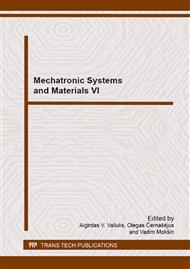p.589
p.595
p.603
p.609
p.615
p.621
p.627
p.633
p.640
The Analysis of Finishing Tooling Influence on Friction Factor Examined by T-05 Tester
Abstract:
The article presents the research results referring to the analysis of the influence of finish treatment (finishing turning, grinding, burnishing) on the friction factor of steel applied to marine pump shafts. The research was performed on a roller 39 mm in diameter made of stainless steel 304L. The finish tooling of pump shaft pins was carried out on a universal centre lathe. The finish turning process was carried out by means of a WNMG WF 080408 Sandvik Coromant cutting tool with replaceable inserts. The grinding process was performed by grinding attachment for lathes. The 1 – 80×10×32 – 99C 80-N V grinding wheel was used for the process. The process of burnishing was done by SRMD burnishing tool by Yamato. The burnishing process could be carried out at the following technological parameters: burnishing force 1.1 kN, burnishing speed 35 m/min, feed 0.13 mm/rev [1, 2, 3]. The paper aimed at defining the influence of burnishing on service conditions by: testing electrochemical corrosion, friction wear and contact fatigue. The work presented the research results of friction factor tests of the samples after finish turning, grinding and burnishing. In addition, the influence of the burnisher passes number on the friction factor was determined. The experiment was performed on block – roll tester machine.
Info:
Periodical:
Pages:
615-620
Citation:
Online since:
January 2015
Authors:
Keywords:
Price:
Сopyright:
© 2015 Trans Tech Publications Ltd. All Rights Reserved
Share:
Citation:


